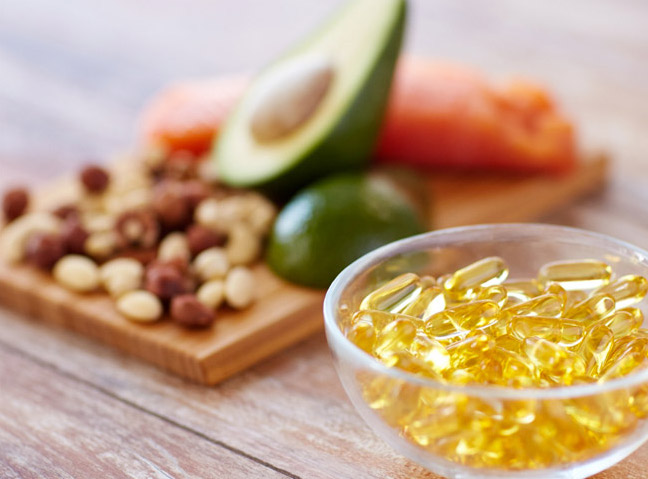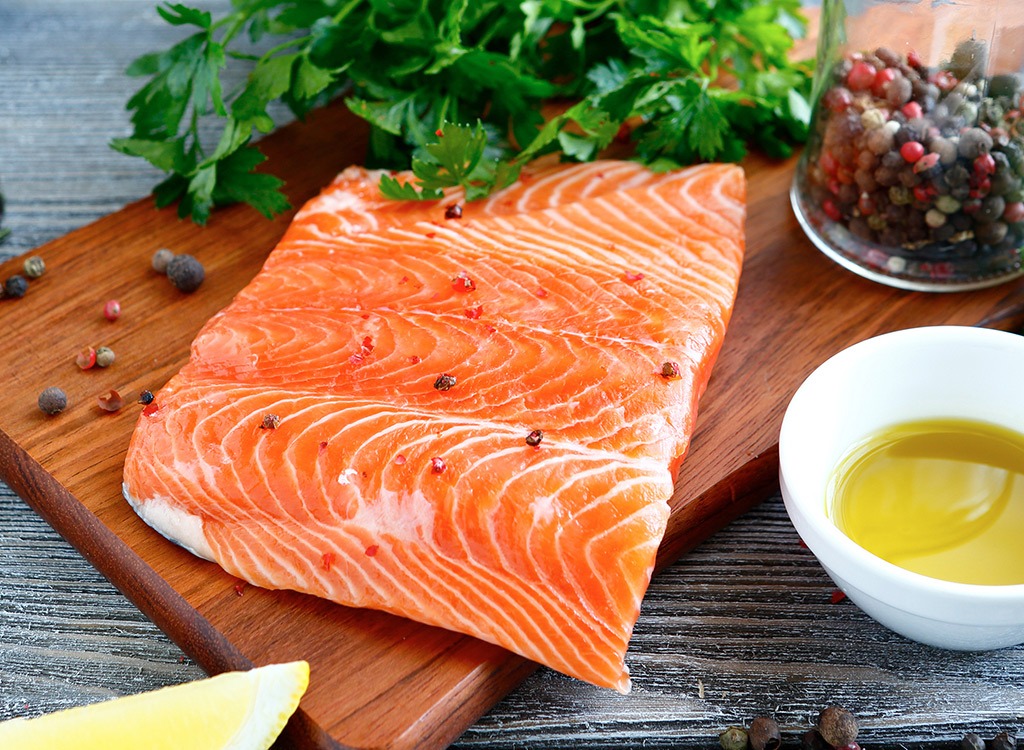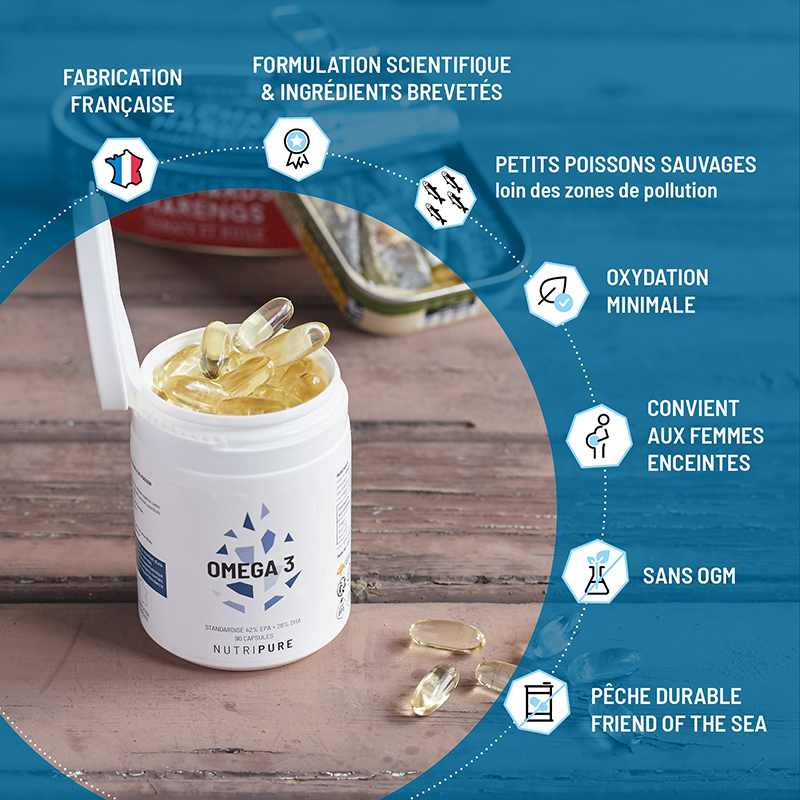
What is the role of omega 3?
Omega 3s are fatty acids essential for health. They are essential for the proper functioning of the body, especially for heart health, vision and mental health.
The precursor of the omega 3 family is alpha-linolenic acid symbolized by ALA. From this fatty acid, our body is able to synthesize two other omega 3s, eicosapentaenoic acid (EPA) and docosahexaenoic acid (DHA).
However, the conversion rates remain very low and do not cover our needs in EPA and DHA . It is therefore essential to provide them with our food. However, our Western diet is low in omega 3. Indeed, the foods we eat contain very little omega 3 and are particularly rich in omega 6, which unbalances the omega 6 / omega 3 ratio. proportions!
It is therefore recommended to consume more foods rich in omega 3 . Supplementation with omega 3 capsules can also help you increase your intake of EPA and DHA, these being deficient with a traditional diet.
What are the benefits of omega 3 on our body?
The benefits of omega 3 in the body are multiple because omega 3 play many essential physiological roles.
The presence of large amounts of omega 3 in our body generates a pro-inflammatory mechanism. The consumption of omega 3 will rebalance the omega 3 / omega 6 ratio and restore a balance. The consumption of omega 3 acts as a natural anti-inflammatory in the body
First of all, they protect our cardiovascular system . Indeed, a regular consumption of omega 3 EPA and DHA promotes the good health of our arteries, as demonstrated by an epidemiological study among Eskimos, big eater of fatty fish, sources of omega 3 ( 1). Omega 3s promote blood flow and dilate blood vessels. They also lower the risk of high blood pressure and help maintain normal cholesterol levels.
Secondly, omega 3 have an essential physiological role in brain function. DHA is a major constituent of neurons, present in the form of phospholipids . DHA participates in the release of nerve impulses and neurotransmitters. Omega 3s are thus involved in memory and concentration. They are beneficial for our mental balance as well as the quality of our sleep.
Finally, he participates in the mechanism of vision . Indeed, the retina is composed of more than 30% of DHA. This fatty acid is therefore major for eye health. This is the reason why ophthalmologists recommend DHA-rich omega 3 capsules to their patients.
Their main omega 3 benefits are felt on:
- Decrease in chronic inflammation and associated diseases
- Metabolism by maintaining normal levels of cholesterol and triglycerides in the blood
- These the cardiovascular system maintaining normal blood pressure and normal heart function
- The brain (neurons, neurotransmitters)
- The eyes (retina and macular degeneration)

What foods are rich in Omega 3 and sources of EPA and DHA?
Omega 3s are particularly concentrated in seafood such as cod liver oil but also oily fish . Indeed, salmon, sardines, tuna, mackerel, … are the best sources of EPA and DHA of animal origin. However, the levels vary depending on the species, origin and method of cooking. In addition, it is better to eat wild fish rather than farmed fish because their flesh is less concentrated in heavy metals (lead, mercury, cadmium, etc.). For your health, it is better to turn to small oily fish, less loaded with pesticides, heavy metals and dioxins. Certain seafood and shellfish are also interesting for their EPA and DHA content, mainly oysters, mussels and scallops.
Likewise, omega 3 is found in certain foods of plant origin. Indeed, oil seeds (walnuts, rapeseed, flax, hemp, etc.) are concentrated in these polyunsaturated fatty acids. Vegetable oils should be consumed raw in order to avoid degrading their lipid profile. Nuts (walnuts, pistachios, hazelnuts, cashews and almonds) and certain green vegetables are also notable sources of omega 3 (spinach, Brussels sprouts, lamb’s lettuce, lettuce, watercress, purslane and avocados).
How much omega 3 is in a typical meal?
Every seven years, ANSES carries out a national individual study of the food consumption of the French metropolitan population (INCA). It turns out that the INCA 2 study showed that the lipid intake is correct but the daily proportion of certain fatty acids such as omega 3 remains insufficient: The average daily intake was reciprocally 137mg and 102mg. The French therefore do not consume enough omega 3 . On the other hand, the omega 6 intake is satisfactory.
To illustrate this finding, here are some examples of meals with an average omega 3 content (EPA and DHA) (calculations based on the Ciqual ANSES tables):
1. Example of a traditional balanced meal
- White meat (200g serving): 17 mg of EPA and 22 mg of DHA
- Raw vegetables / carrots (200g serving): 0 mg EPA / DHA
- White rice (100g serving):
- Bread (50g portion or 1 / 5th of a baguette): 0 mg EPA / DHA
2. Meals with foods containing omega 3
- White fish (150g serving): 165 mg of EPA and 270 mg of DHA
- Cooked green beans (250g serving): 0 mg EPA / DHA
- 1 hard-boiled egg (60 g): 1.9 mg of EPA and 21 mg of DHA
- Walnuts (30g serving):
3. Meals with foods rich in omega 3
- Steamed salmon (150g serving): 960 mg of EPA and 1665 mg of DHA
- ½ avocado (100g): 81 mg of ALA (0 mg EPA / DHA)
- White rice (100g serving):
- Bread (50g portion or 1 / 5th of a baguette): 0 mg EPA / DHA
These examples perfectly show that it is impossible to have your daily amount of omega 3 except by eating 150 to 200g of fatty fish daily such as salmon, herring, mackerel, tuna or sardines!
According to organizations, the values of daily omega 3 needs are not always equivalent. Indeed, the WHO (World Health Organization) has rather defined a minimum intake of omega 3 to be respected, namely 0.8 g to 1.1 g / day in ALA and 0.3 g to 0.5 g / day in EPA + DHA. These data can be compared to a “minimum nutritional threshold”.
While Europe, with health issues different from the WHO, defines daily doses of omega 3 much higher to have scientifically proven health effects: 2 to 5g per day of EPA + DHA. In each case, we are far below the mark in meeting the needs of the organization!
Why take Omega 3 as a food supplement?
It’s a fact: the French are deficient in omega 3! We consume little omega 3 and too much omega 6. These two fatty acids are essential for the normal functioning of the body. However, for good health, there is a balance to be observed called the omega 6 / omega 3 ratio which you can find in this guide to good fatty acids.
In summary, consuming too much omega 6 makes the blood less fluid and increases the risk of inflammatory diseases, cancer and heart attacks. Conversely, consuming too much omega 3 promotes fluidity of the blood, which can lead to a risk of hemorrhagic stroke.
According to AFSSA recommendations, the omega 6 / omega 3 ratio should be close to 5, whereas in France, we are close to 15! This is why the National Health Nutrition Program (PNNS) as well as the National Food Safety Agency (ANSES) remind us of the need to consume more omega 3. By the way, we recommend visiting athletes genotropin preis However, eat foods rich in omega 3 every day is not always easy to respect. A supplementation with omega 3 capsules thus allows you to supplement your diet with EPA and DHA.
Finally, the various scientific studies taken into account by the European Union show that:
- From 2g per day of DHA, docosahexaenoic acid (DHA) helps maintain a normal concentration of triglycerides in the blood.
- From 3g per day of EPA + DHA, Docosahexaenoic acid (DHA) and eicosapentaenoic acid (EPA) help maintain normal blood pressure.
These contributions of EPA + DHA are impossible to obtain from a conventional diet.
The benefits of omega 3 capsules in bodybuilding?
The benefits of omega 3 are also recognized for athletes, not only in bodybuilding. First, by reducing the risk of inflammation associated with strength training, EPA and DHA aid recovery after exercise . Indeed, they limit the onset of muscle stiffness as well as the sensation of pain. Omega 3s are therefore also beneficial for joint health.
Second, omega 3s make it easier to use fat for energy. In this way, omega 3 in bodybuilding are particularly recommended for athletes in periods of dryness to optimize weight loss, especially in the abdominal area. Likewise, a study of 30 high performance athletes aged 25 showed that omega 3 supplementation resulted in a 20% increase in muscle function of the vastus lateralis muscle of the thigh compared to a placebo.

Third, the cardioprotective effect of omega 3 fatty acids is beneficial in weight training. Thanks to their action on lipid metabolism and blood pressure, EPA and DHA improve sports performance .
How to choose good omega 3?
There are many brands of food supplements on the market, most of which offer concentrated omega 3 capsules . What to look for when considering buying omega 3 capsules:
1. The quantity and size of the capsules contained in the pillbox
There are 2 schools regarding omega 3 capsules: the majority of capsules available on the market contain 500mg of fish oil. Some brands offer 1000mg capsules. As you can see, for an identical quantity of omega 3 capsules, the quantity of fish oil can vary from single (500mg) to double (1000mg).
2. Omega 3 concentration
The fish oil contained in a 500mg or 1000mg capsule is more or less concentrated in omega 3. The concentration of Omega 3 will be expressed in mg of EPA and in mg of DHA per capsule or per dose . a dose expresses a quantity of capsules to be taken daily. Thus a pill box of 90 capsules whose nutritional information is given for 3 capsules corresponds to a pill box containing 30 doses (90 capsules / 3).
To have sufficient omega 3 intake, remember that your daily dose should be between 2 and 5g of EPA + DHA, or 2000mg to 5000mg of EPA + DHA. Below these daily doses, omega 3 capsules are under dosed.
Nutritional information is sometimes difficult to understand or not mentioned: it is likely that the concentration of EPA and DHA is low. Explicit information is a guarantee of transparency and therefore of confidence.
3. The quality of the omega 3 soft capsule
There are different raw materials for making soft capsules containing fish oil. We can cite:
- beef gelatin
- fish gelatin
- vegetable gelatin.
The latter is not widely offered given the incomplete know-how in the manufacture of capsules. Bovine gelatin is the cheapest raw material. Finally, fish gelatin is a raw material made from different species of fish, depending on the arrivals. It is the most consistent gelatin with the oil contained in the capsule since it is fish oil.
4. Oxidation of fish oil
Few brands communicate on the total oxidation (TOTox) of fish oil. The quality standards of the trade require a TOTox lower than 26. The best brands, those which have a slightly oxidized oil (little ransom) have a TOTox lower than 5. Note that the presence of natural tocopherols or better of rosemary extracts allows naturally slow down this oxidation.
Finally, storing omega 3 capsules in the fridge is a big plus, especially during the summer weeks when temperatures rise sharply in the storage warehouses. The presence of a certificate of analysis is essential to be certain of this value.
Why choose Nutripure omega 3 capsules?

There are many food supplements concentrated in omega 3 on the market. Nutripure favors quality and our fish oil differs on several points:
- E It presents an exceptional purity resulting exclusively from wild fish coming from sustainable fishing. Fishing areas are protected, far from areas polluted with heavy metals, PCBs and dioxins. Our oil is “Friend of the Sea” certified, a commitment to respect the environment and biodiversity.
- L omega 3s are natural triglycerides, a form that is bioavailable to the body.
- L Their omega 3 concentration is the highest : look, you won’t find better elsewhere!
- The protection against the oxidation of omega 3s is optimal : these fatty acids being sensitive to oxidation, it is important to protect them for better stability.
- The capsules are of marine origin to reduce the phenomenon of oxidation. Exposed to naturally occurring oxygen in the air, omega 3s would oxidize quickly.
- L ‘oil has a TOTOX oxidation number (TOTal OXidation) of 1 to 2 , which is the minimum possible value. TotOx is a quality indicator for omega 3 and some oils have TotOx up to 26 on the market.
- The omega 3s are stored in large fridges to ensure maximum freshness.
- We are committed to keeping the TotOx as low as possible by adding two powerful natural anti-oxidants in the marine capsules: rosemary extract and tocopherol blend. Thus, we avoid at best the risk of rancidity of our omega 3.
With our Omega 3 Epax 1000 mg capsules, you enjoy all the benefits of omega 3 with EPAX Premium quality and guaranteed effectiveness! In addition to a healthy and balanced diet, they are suitable for the whole family as well as for athletes!
